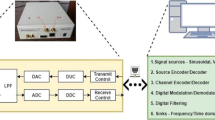Abstract
The joint detection and verification of frequency shift keying (FSK) modulation and demodulation (MODEM), Manchester coding and decoding (CODEC) schemes are proposed for dedicated short range communication (DSRC) systems over high mobility fading channels. The proposed joint coded-FSK detection scheme with low complexity advantage can outperform the conventional separated coded-FSK detection scheme. It is due to the joint scheme with time diversity gain to enhance the detection performance. Moreover, the proposed joint algorithms with floating-point and fixed-point designs are realized in the software-defined-ratio (SDR) platform. Based on the measurement results via SDR equipments, it is confirmed that the implementation of VHDL hardware circuit design of the proposed joint detection scheme can provide robust performance over high mobility Rician multipath fading channel environment.













Similar content being viewed by others
References
Sasho, N, et al. (2008). “Single-Chip 5.8 GHz DSRC transceiver with dual-mode of ASK and Pi/4-QPSK,” IEEE Radio and Wireless Symposium, 799–802.
Kwon, K., Choi, J., Hwang, Y., Lee, K., & Ko, J. (2011). A 5.8GHz integrated CMOS dedicated short range communication transceiver for the Korea/Japan electronic toll collection system. IEEE Transactions on Microwave Theory and Techniques, 58(11), 2751–2763.
Kenney, J. B. (2011). Dedicated short-range communications (DSRC) standards in the United States. Proceedings of the IEEE, 99(7), 1162–1182.
Ho, K. Y., Kang, P. C., Hsu, C. H. and Lin, C. H. (2010). “Implementation of WAVE/DSRC devices for vehicular communications,” International Symposium on Computer Communication Control and Automation, 522–525.
ML5800 Datasheet, “5.8GHz low-IF 1.5Mbps FSK transceiver”, Micro Linear Corporation, Mar. 2004. [Online]. Available: http://www.microlinear.com
ML5830 Datasheet, “Low power integrated 5.8GHz ASK/FSK transmitter”, Micro Linear Corporation. [Online]. Available: http://www.microlinear.com
Rice Univ. Wireless Open-Access Research Platform Project. [Online]. Available: http://warp.rice.edu/
Mar, J., Kuo, C. C., Lin, Y. R., & Lung, T. H. (2009). Design of software defined radio channel simulator for wireless communications: case study with DSRC and UWB channels. IEEE Transactions on Instrumentation and Measurement, 58(8), 2755–2766.
Umemoto (2001). “An experimental DSRC multimode terminal using software defined radio technology,” IEEE Radio and Wireless Conference, 165–168.
Bakhraiba, A., et al. (2008). “Digital modulation identification in terms of software defined radio for traffic management system,” IEEE National Conference on Telecommunication Technologies, 278–283.
Mar, J., Kuo, C. C. and Chou, S. H. (2012) “FPGA implementation of SDR based CFO estimation and compensation circuit for OFDM system,” Journal of Signal Processing System, DOI 10.1007/s11265-011-0621-y, 141–146.
Proakis, J. G., Salehi, M. and Bauch, G. (2007). Contemporary Communication Systems Using MATLAB, PWS Publishing Company, 314–320.
Mecklenbrauker, C., et al. (2011). Vehicular channel characterization and its implications for wireless system design and performance. Proceedings of the IEEE, 99(7), 1189–1212.
Elektrobit Propsim C2 hardware channel emulator. [Online]. Available: http://www.propsim.com
Acknowledgments
This work was sponsored by the National Science Council, R.O.C., under Contract NSC 101-2220-E-155-006 and NSC 102-2218-E-155-001. The authors express their gratitude to Editor and reviewers for their helpful comments and suggestions in improving the quality of this paper.
Author information
Authors and Affiliations
Corresponding author
Rights and permissions
About this article
Cite this article
Deng, JH., Hsiao, FC. & Lin, YH. Top Down Implementation of Joint MODEM and CODEC Transceiver Design for DSRC Coded-FSK Systems Over High Mobility Fading Channels. J Sign Process Syst 79, 263–270 (2015). https://doi.org/10.1007/s11265-013-0838-z
Received:
Revised:
Accepted:
Published:
Issue Date:
DOI: https://doi.org/10.1007/s11265-013-0838-z




